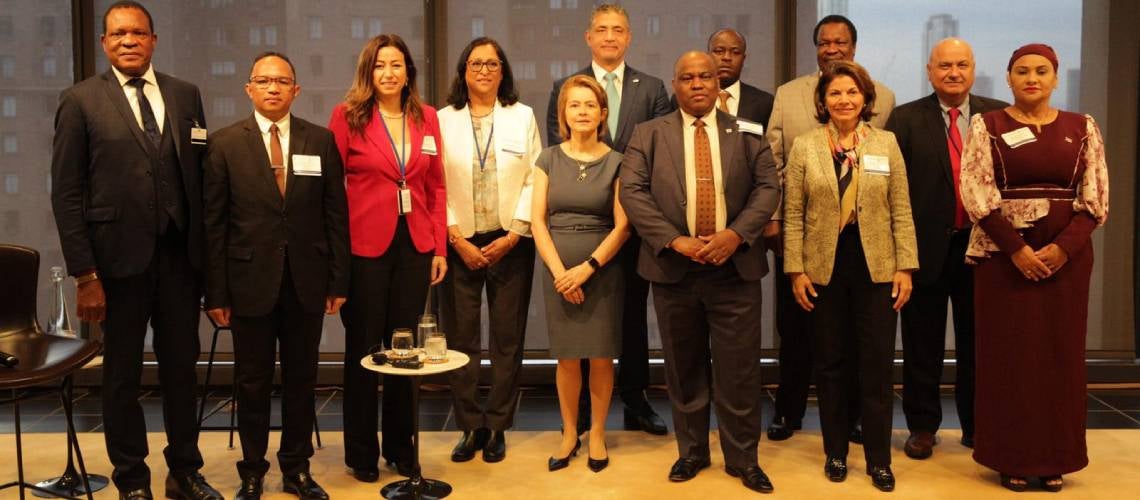 Water ministers from Eastern and Southern Africa and development partners gathered at the UN 2023 Water Conference to discuss new approaches to expanding access to water and sanitation.
Water ministers from Eastern and Southern Africa and development partners gathered at the UN 2023 Water Conference to discuss new approaches to expanding access to water and sanitation.
Access to clean water and proper sanitation is a fundamental human right, yet millions of people in Eastern and Southern Africa continue to lack access to these basic services. And while the world is progressing to achieve SDG 6, Africa is unfortunately the only region sliding backwards.
The numbers are staggering
In 2020, around 387 million people still lacked a basic level of drinking water service, 737 million lacked basic sanitation services (including 197 million who practiced open defecation), and 811 million still lacked or had limited access to basic hygiene services. Around half of schools and health facilities lacked access to proper water and sanitation services (WSS).
And over the past decades, 37 million more Africans were without basic drinking water and 247 million more were without basic sanitation. Significant inequalities also persist between urban and rural regions within countries. About 86% of those without water and 70% of those without sanitation live in rural areas. And finally, the continent is seeing a fast urbanization trend, with 350 million more Africans living in cities by 2030, yet cities are running dry, and livability of major cities already compromised as bulk water supply runs short and users today only get a fraction of the water they need.
The economic and human developments costs associated to these gaps are too high. Our water security diagnostics show that by 2050, water scarcity could reduce GDP by 6%. Half of global maternal deaths occur in Sub-Saharan Africa. Poor water, sanitation, and hygiene (WASH) also lead to increased diarrheal diseases, which is still the leading cause of death in the region, causing more than 8% of child deaths. Nearly 35% of all children are stunted, which is in part attributable to unsafe water, inadequate sanitation, and insufficient hygiene. Simple hygiene interventions, such as handwashing, could drastically improve health outcomes. Having a water source and sanitation facilities at home or close to home is especially beneficial for women and children. Easy access to safe water and sanitation can help safeguard the safety, dignity, and wellbeing of women and girls, who are often at risk for gender-based violence as they collect water or use sanitation facilities.
In Ghana, a halving of water fetching time increases girls’ school attendance by 2.4 percentage points on average, with stronger impacts in rural communities. Similarly, access to treated, piped water inside the home is causally linked to a higher number of completed school years in 39 African countries.
To combat these staggering statistics and trends, “Business as usual” is simply not an option. Population growth is too high, and retail-based approaches to projects – mostly focused on infrastructure – in suboptimal institutional environments are not delivering sustained solutions at scale. We need a different approach; a “Systems Change” is necessary to move the needle at a faster and more sustainable pace in closing the water and sanitation gaps. AFE region is calling for an increased ambition in closing the WASH access gap , centered around five strategic actions:
1. Address policy and institutional reforms: Investment programs should be based on a solid institutional, policy and regulatory framework. National prioritized investment programs can be effective vehicles to scale up access if they are anchored in a solid institutional framework with strong Government championship. This can be built by:
- addressing financial and institutional capacities,
- providing clarity in roles in responsibilities,
- improving intergovernmental coordination,
- strengthening oversight, regulation, and reporting.
Kenya is an example where long-term institutional reform process, including the devolution of WSS services to counties, have led to positive results in scaling up access. These reforms started with the separation of functions, creation of regulatory bodies, then devolution of services, and are now culminating with the creation of a robust investment framework bringing together both national and sub-national entities, as a key vehicle to scaling up access.
2. Create incentives for more efficient service providers: Most of our utilities are still working very inefficiently and their operations are heavily subsidized. Every dollar of government funding spent in subsidizing the operation of inefficient utilities, is a wasted opportunity to use those resources in expanding services. World Bank IBNET data on utilities shows that there has been no progress on cost recovery levels in Sub-Saharan Africa’s major utilities in the last 15 years. We need a stronger push to support utilities in reducing technical losses and moving up the financial sustainability ladder so they can become creditworthy.
3. Leverage private and partner financing: Achieving universal access to water supply and sanitation will require a four to five times increase of current investment levels. Effective Government funding remains the cornerstone, centered around efficient sector management. At the same time, development partner support is still a drop in the ocean even if increased substantially. Governments need national investment programs which mobilize domestic resources, create predictable and transparent revenues, and are backed by strong and credible institutions. That is also the way to also attract private sector capital where opportunities exist to help bridge the access gap.
4. Build resilience through storage: Investing in green and gray storage is essential in a context of rapid population growth and increased climate variability, and in many areas of the continent investments in storage have lagged behind. Protecting and enhancing natural storage options in watersheds and underground, as well as repurposing and optimizing existing storage to serve multiple uses, will have major impacts, particularly in rapidly growing cities, or in expanding irrigation services, essential for food security.
5. Prioritize country and regional collaboration platforms: It is through examples like the One-Wash program in Ethiopia that scaling up access can be accelerated.
This program consists of a government led, multi-donor platform with 8 different partners pooling together financial resources for $650 million across different sectors (education, health, energy, water, finance) to increase water and sanitation access. This approach is demonstrating that government ownership, and improved coordination leads to stronger and more sustained results.
Looking forward
Closing the widening access gap in Eastern and Southern Africa requires a long-term and sustained effort, packed with ambition, investment, innovation, and collaboration. The World Bank is dedicated to realizing universal access to water, sanitation, and hygiene in the region, through accelerating the implementation of our current WASH portfolio, scaling-up financing in the coming three years, and partnering with regional organizations to achieve impact at scale.
But we cannot do this alone.
Last week, during the 2023 UN Water Conference, Eastern and Southern Africa water ministers and development partners gathered to commit to a new way of doing business: A strengthened Ambition through scaled up Systems Approach, coupled with accelerated Action in implementation of current and new investment programs. Finally, a collective Accountability, through establishing regional and national coordination platforms, where countries will lead the way and development partners follow the scaling up efforts in a more coordinated manner, and we can continue to track the effort to demonstrate visible results in reversing the trends and closing the growing WASH access gap.
Related Links:
Accelerating Change to Solve the Water Crisis
Blog: Two billion people still lack access to safely managed water
Blog: A bold response is needed to achieve a water-secure world
The Road to Better Services Is Paved with Strong Delivery Institutions: A Rural Water Story






Join the Conversation